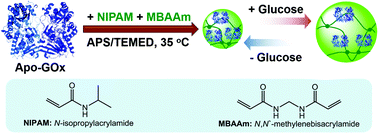Glucose-responsive microgels based on apo-enzyme recognition†
Abstract
Glucose-responsive polymer microgels that can undergo highly selective, reversible, and rapid volume phase transitions in response to fluctuations in blood glucose concentration have the potential to regulate insulin delivery to improve patient compliance and health. Herein, we report such a glucose-responsive polymer microgel, which is made of a representative apo-enzyme, apo-glucose oxidase (apo-GOx), interpenetrated in a chemically-crosslinked network of poly(N-isopropylacrylamide) (pNIPAM). Introduction of apo-GOx into the pNIPAM network made the newly developed semi-interpenetrating-structured microgels responsive with high selectivity to glucose over a glucose concentration range of 0–20 mM at a physiological pH value of 7.4. While the microgels could swell and reach stability shortly (<1 s) after adding glucose over a concentration range of 50.0 μM–20.0 mM, the changes in the average hydrodynamic diameter and the size distribution of the microgels could be fully reversible within experimental error even after twenty cycles of adding/removing glucose. The association rate constant was determined to be ca. 1.0 mM−1 s−1 with a ca. 10.1 s−1 dissociation rate constant, indicating a fast reversible time response to the glucose concentration change of the microgels. With the microgels as carriers, in vitro insulin release could be modulated in a pulsatile profile in response to glucose concentrations, and in vivo studies revealed that these formulations may improve glucose control in streptozotocin-induced diabetic mice subcutaneously administered with the insulin loaded microgels.


 Please wait while we load your content...
Please wait while we load your content...